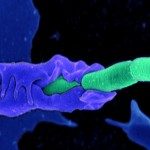Link to Pubmed [PMID] – 23029226
PLoS ONE 2012;7(9):e45758
Infections caused by multidrug-resistant bacteria are a major concern in hospitals. Current infection-control practices legitimately focus on hygiene and appropriate use of antibiotics. However, little is known about the intrinsic abilities of some bacterial strains to cause outbreaks. They can be measured at a population level by the pathogen’s transmission rate, i.e. the rate at which the pathogen is transmitted from colonized hosts to susceptible hosts, or its reproduction number, counting the number of secondary cases per infected/colonized host. We collected data covering a 20-month surveillance period for carriage of multidrug-resistant Acinetobacter baumannii (MDRAB) in a surgery ward. All isolates were subjected to molecular fingerprinting, and a cluster analysis of profiles was performed to identify clonal groups. We then applied stochastic transmission models to infer transmission rates of MDRAB and each MDRAB clone. Molecular fingerprinting indicated that 3 clonal complexes spread in the ward. A first model, not accounting for different clones, quantified the level of in-ward cross-transmission, with an estimated transmission rate of 0.03/day (95% credible interval [0.012-0.049]) and a single-admission reproduction number of 0.61 [0.30-1.02]. The second model, accounting for different clones, suggested an enhanced transmissibility of clone 3 (transmission rate 0.047/day [0.018-0.091], with a single-admission reproduction number of 0.81 [0.30-1.56]). Clones 1 and 2 had comparable transmission rates (respectively, 0.016 [0.001-0.045], 0.014 [0.001-0.045]). The method used is broadly applicable to other nosocomial pathogens, as long as surveillance data and genotyping information are available. Building on these results, more epidemic clones could be identified, and could lead to follow-up studies dissecting the functional basis for variation in transmissibility of MDRAB lineages.
